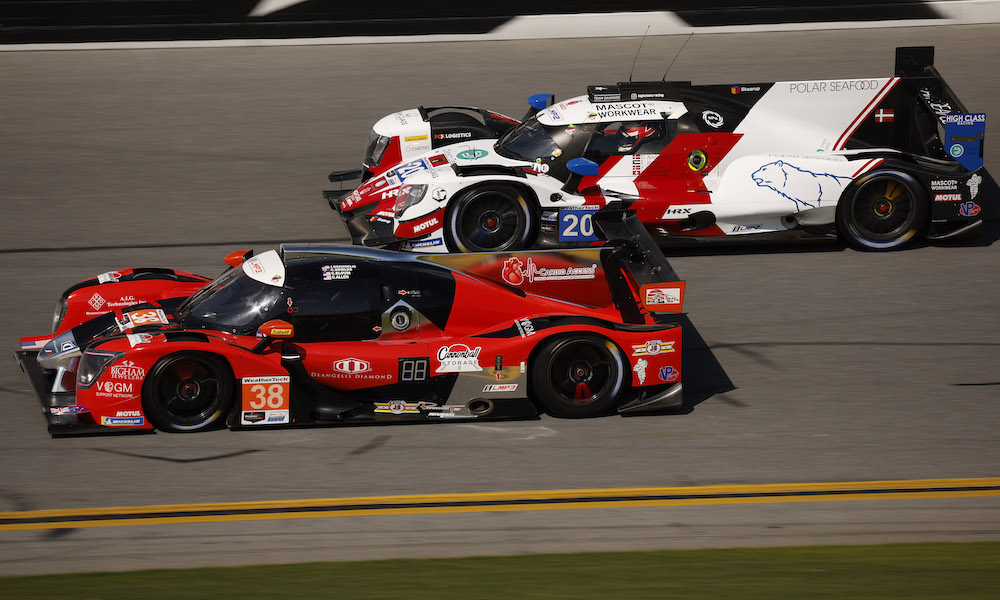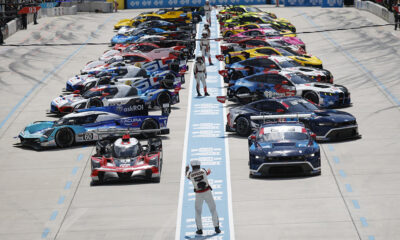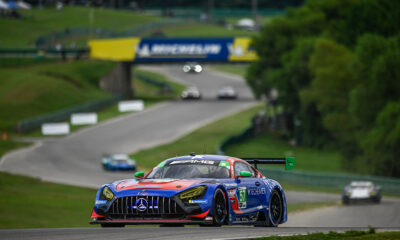LMP2 drivers in the IMSA WeatherTech SportsCar Championship have expressed concern at the extent of performance reductions to their cars for the Roar Before the Rolex 24.
Several competitors in the second-tier prototype class have suggested that they are being backed into the slower LMP3 category by measures implemented to ensure an adequate pace gap between LMP2 and the new top-level LMDh machinery in GTP.
The LMP2 division, which is made up of Oreca 07 Gibsons, received a suite of pre-event adjustments announced in December.
The main changes are a power reduction – consisting of a 35 mm air restrictor and lower revs per minute ranges – along with a 10 kg weight increase since last season and aero tweaks that allow cars to run with less downforce.
Multiple paddock sources estimated that Orecas are carrying around 50 horsepower less than last year, however IMSA has not officially communicated an amount.
Drivers noted that the LMP2s and LMP3s are similar in performance at sections of the Daytona infield. The lower rev limit – 700 RPMs less than last year in first to fifth gear and 200 RPMs less in sixth gear – was widely cited as the main reason for this.
The fastest lap in LMP2 so far this weekend is 1.6 seconds slower than the time that topped last year’s Roar.
“I think the biggest thing for us is the RPM reduction,” PR1/Mathiasen Motorsports driver Ben Keating told Sportscar365.
“We used to have such great acceleration compared to the GT and LMP3 cars. With that reduction in RPM, we drop so low that we have no power when we shift, so we don’t get out of the corner.
“Normally you would pass a GT car between [Turn] 3 and the kink, or coming out of 5 before you get into 6. It’s really hard to do that now, because you don’t have that acceleration.
“It almost feels to me like all the cars have to wait until you get out of Turn 6 to get out of the banking to sort it out. Just because there’s not enough acceleration to be able to get up around somebody with comparable drivers in the car.”
Keating considers the gap between the top category and LMP2 to be ample, describing it as “bigger than it’s ever been.”
“Over time, the GTP cars will get faster and I’m hoping that we get a little bit of it back at some point,” he added. “For Daytona, where you have 24 hours of traffic, the RPM is the big killer.”
Reigning LMP2 champion John Farano, who tested the adjusted Oreca at Daytona in December, feels that the performance changes have brought LMP2 and LMP3 closer together.
“Especially if the Bronze [LMP2 driver] is on a second-stint tire and the Pro [LMP3 driver] just came out on a new tire, it is going to be a fight into the corners,” Farano said.
“Having said that, it brings a lot more risk to the P2 and P3 drivers. I’ve spoken to a lot of P3 drivers, and they’re also concerned. You can’t slow them down because it’s just going to slow them into the GT class.
“From the IMSA standpoint, I’m not criticizing, but there’s a concern I’m expressing there. Maybe they slowed us down just a little bit too much.
“If there was one more second we can gain, in terms of a reduction, I think that would be really helpful. I don’t mind the car. I’m just concerned about the risk between the Bronze driver and the Pro driver in LMP3.”
High Class Racing’s Anders Fjordbach added that some of the faster LMP2 drivers who try to lap cars through the infield are likely to take greater risks.
“You really need to out-brake them to pass them,” he said. “This will go wrong at some point.
“All teams, as far as I know, are struggling with brake temperatures because we’re going that much slower. It affects so many things.”
The slowing down of the LMP2 field is also impacting the experience of LMP3 drivers, according to Wayne Boyd who is in one of the AWA team’s Duqueine D08 Nissans.
“With a fast driver in a P2, it’s not so bad, because it’s easier to tell,” the 2020 European Le Mans Series LMP3 champion told Sportscar365.
“If you have a Bronze driver in the car and a Pro in the P3, there is very, very little time difference. I actually had it with a P2 in testing and I passed him, but he never got back past.
“Whenever I got away in the infield, coming onto the straight he wasn’t fast enough to catch me before the Bus Stop. The race is going to be interesting.”
John Dagys contributed to this report




























